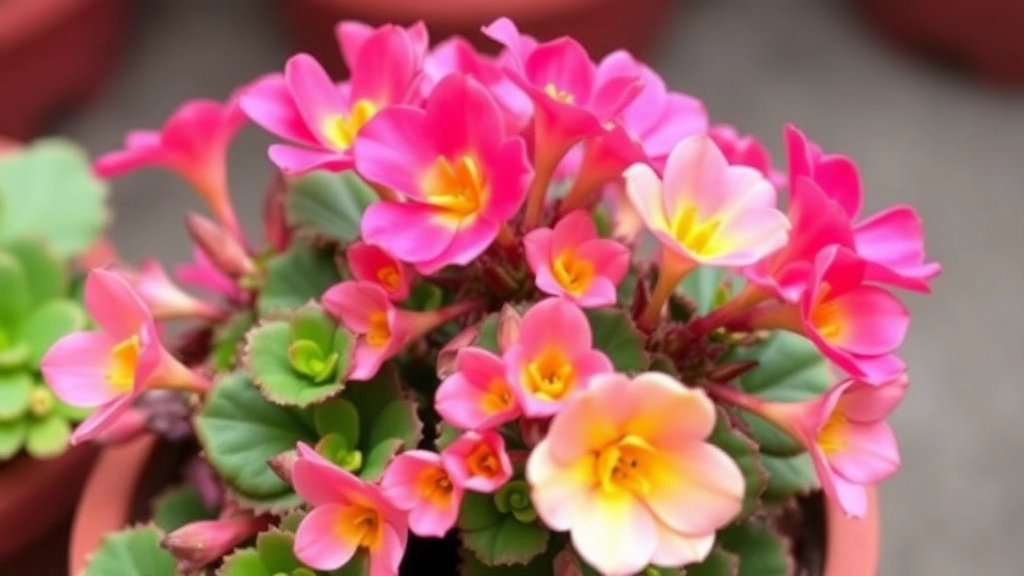Florist Kalanchoe Care Tips
If you’re looking to keep your Florist Kalanchoe thriving, you’ve come to the right place. This vibrant succulent, known for its long-lasting blooms, is a favourite among plant enthusiasts for its low-maintenance needs. Let’s dive into some practical tips for Florist Kalanchoe plant care to ensure your plant stays healthy and beautiful.
Key Aspects of Care
First, light is crucial. Your Florist Kalanchoe loves bright, indirect sunlight. Place it near a window where it can soak up plenty of natural light without getting scorched.
Watering is another key aspect; make sure to water thoroughly but allow the soil to dry out between waterings to prevent root rot. With the right care, your Florist Kalanchoe will reward you with stunning, long-lasting flowers.
### Ideal Light Conditions for Florist Kalanchoe
When it comes to growing Florist Kalanchoe, one of the most pressing concerns is ensuring the right light conditions.
#### Why is Light Important?
Kalanchoe thrives in bright, indirect sunlight.
If you’re struggling to keep your plant healthy, consider these key points:
– **Direct Sunlight:** While Kalanchoe can tolerate some direct sunlight, too much can scorch its leaves.
– **Indirect Light:** A south or west-facing window is ideal. This allows the plant to soak up ample light without the harsh midday sun.
– **Artificial Light:** If natural light is insufficient, using a grow light for 12-14 hours a day can be beneficial.
#### Signs of Insufficient Light:
– Leggy growth
– Yellowing leaves
– Slower blooming
For more detailed tips on keeping your Kalanchoe healthy, check out our [complete guide to growing Kalanchoe Pink Flowers](https://planthq.org/ultimate-guide-to-growing-kalanchoe-pink-flowers/) and learn how to [care for your Kalanchoe succulent](https://planthq.org/caring-for-your-kalanchoe-succulent-a-complete-guide/).
Watering Schedule and Tips for Preventing Overwatering
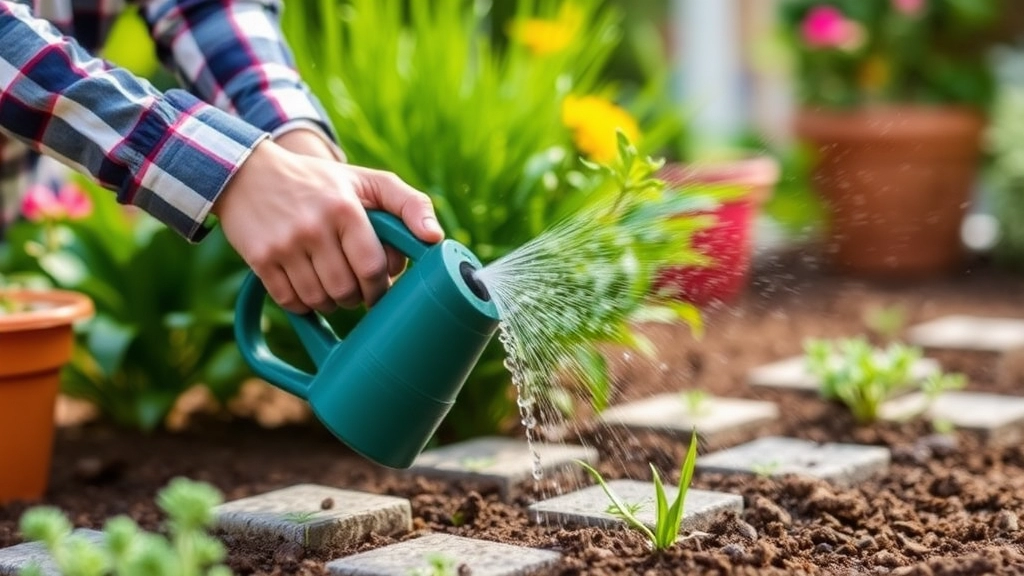
So, you’ve got your beautiful Florist Kalanchoe, and you’re probably wondering, “How much should I water this thing?”
Watering can be a bit tricky, especially when it comes to succulents like Kalanchoe. Too much water, and you might end up with root rot. Too little, and those vibrant leaves could start to droop.
Watering Schedule
- Frequency: Generally, water your Kalanchoe every 2-3 weeks.
- Seasonal Adjustments:
- In summer, you might need to water more often due to heat.
- In winter, reduce watering to once a month or even less.
Tips for Preventing Overwatering
- Check the Soil: Stick your finger into the soil about an inch deep. If it feels dry, it’s time to water. If it’s still moist, hold off.
- Use Well-Draining Pots: Make sure your pot has drainage holes. This helps excess water escape, keeping roots happy.
- Water Thoroughly: When you do water, give it a good soak. Let the water drain out completely.
- Observe Your Plant: Look for signs of distress. Yellowing leaves? That could be a sign of overwatering.
- Adjust for Environment: If your Kalanchoe is in a humid spot, you might need to water less. Conversely, in a dry area, it may need more frequent watering.
Best Soil Types for Kalanchoe Health
When caring for your Florist Kalanchoe, the right soil plays a crucial role in promoting its overall health and vitality.
What Soil is Best for Kalanchoe?
Kalanchoe thrives in well-draining soil that allows excess moisture to escape. Here are the key types of soil you should consider:
- Cactus Mix: A pre-packaged cactus mix is an excellent choice. It typically contains sand, perlite, and other materials that ensure proper drainage.
- Succulent Soil: Similar to cactus mixes, succulent soil is formulated specifically for plants that require less moisture. It’s light and airy, preventing root rot.
- DIY Mix: You can create your own soil mix by combining:
- 2 parts potting soil
- 1 part perlite or coarse sand
- 1 part pumice or gravel
Why Drainage is Key
Kalanchoe is sensitive to overwatering, and the right soil helps mitigate this risk.
- Aeration: Good soil allows air to reach the roots, promoting healthy growth.
- Moisture Control: Well-draining soil helps regulate moisture levels, ensuring your Kalanchoe gets just the right amount of water without sitting in soggy conditions.
Signs of Poor Soil Quality
If you notice any of the following, it might be time to reassess your soil:
- Yellowing leaves
- Wilting despite adequate watering
- Root rot or mushy roots
Choosing the right soil is essential for your Kalanchoe’s success. For more detailed care instructions, you can refer to our comprehensive guide on Kalanchoe care. Additionally, if you’re interested in learning about different species, check out our article on 150 species of Kalanchoe succulent plants.
How to Encourage Longer Blooms
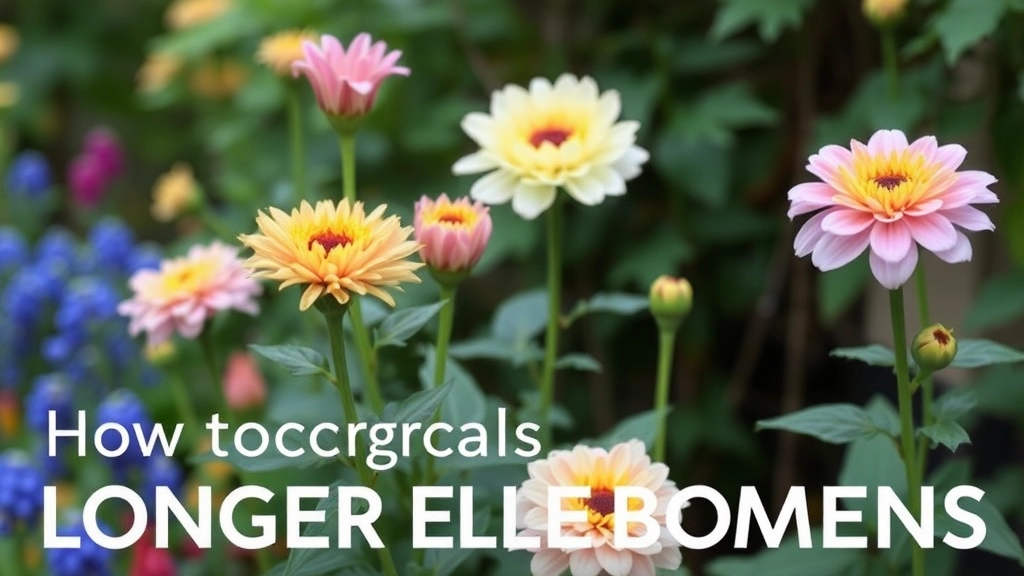
After ensuring your Florist Kalanchoe is thriving under ideal light conditions, the next step to prolonging its beautiful blooms is understanding the factors that contribute to flowering longevity.
Key Factors for Longer Blooms
- Light Exposure
Ensure your Kalanchoe receives bright, indirect sunlight.
Avoid harsh afternoon sun, which can scorch the leaves and shorten blooming periods. - Temperature Control
Maintain a comfortable temperature between 18°C and 24°C.
Avoid sudden temperature drops, as they can stress the plant and reduce flowering. - Watering Practices
Water your Kalanchoe only when the top inch of soil feels dry.
Overwatering can lead to root rot and diminish blooming. - Deadheading
Regularly remove spent flowers to encourage the plant to produce new blooms.
This not only keeps your plant looking tidy but also stimulates further flowering. - Fertilization
Use a balanced, water-soluble fertilizer every two weeks during the blooming season.
This provides essential nutrients that support flower production. - Stress Management
Avoid moving your Kalanchoe frequently, as this can shock the plant.
Consistency is key to encouraging extended blooming.
Real-Life Example
I once had a Kalanchoe that seemed to bloom beautifully, but the flowers started to fade quickly. After adjusting its light exposure and implementing a strict deadheading routine, I noticed a remarkable difference. The plant not only thrived but also produced blooms for weeks longer than before.
Fertilizing Florist Kalanchoe for Optimal Growth
Are you wondering how to keep your Florist Kalanchoe thriving? Proper fertilization is key to achieving vibrant blooms and healthy foliage.
Choosing the Right Fertilizer
When selecting a fertilizer for your Kalanchoe, consider the following:
- Balanced Fertilizer: A 20-20-20 NPK (nitrogen, phosphorus, potassium) formula is ideal.
- Liquid Fertilizer: Opt for a water-soluble option that can be easily absorbed by the plant.
- Slow-Release Granules: These can provide nutrients over an extended period, reducing the frequency of application.
Fertilization Schedule
Timing is everything when it comes to fertilizing your Kalanchoe. Follow this simple schedule:
- Growing Season: Fertilize every 4-6 weeks during spring and summer.
- Dormant Period: Cut back on fertilizing in autumn and winter, as the plant’s growth slows down.
Application Tips
To ensure your Kalanchoe absorbs nutrients effectively, keep these tips in mind:
- Dilute the Fertilizer: Always mix the fertilizer with water according to the package instructions to avoid burning the roots.
- Water Before Fertilizing: Ensure the soil is moist before application to help prevent root shock.
- Observe Plant Response: If you notice yellowing leaves or stunted growth, adjust your fertilization routine accordingly.
Additional Nutritional Needs
Beyond standard fertilization, consider these enhancements:
- Calcium: A calcium boost can strengthen cell walls, promoting sturdier growth.
- Magnesium: This is essential for chlorophyll production, enhancing leaf colour and overall health.
For more detailed care tips, check out our Florist Kalanchoe White Care Guide and learn about why your Kalanchoe might not be flowering.
Propagation Techniques: Cuttings, Offsets, and Seeds
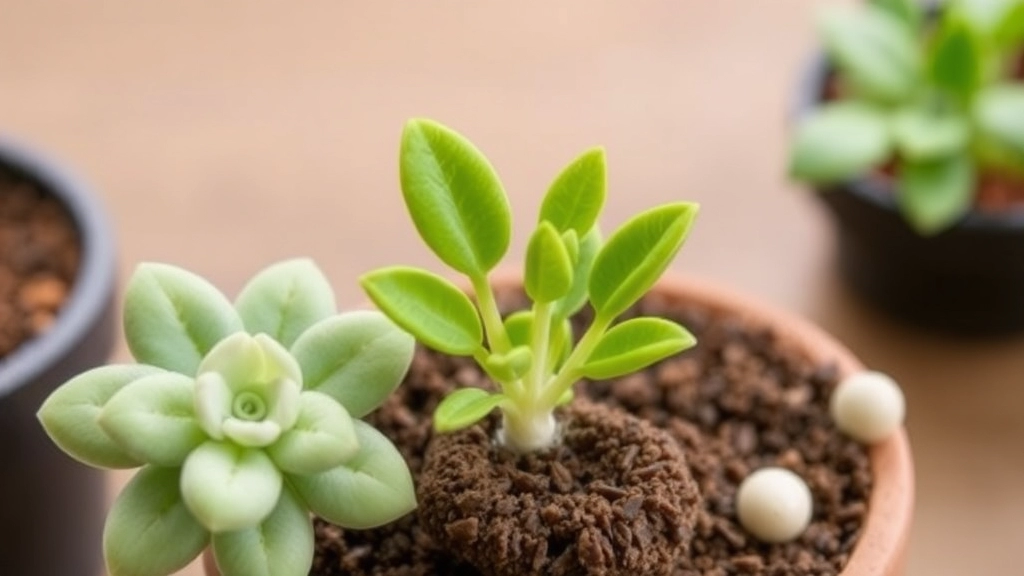
So you’ve enjoyed your Kalanchoe blooms and are thinking about how to multiply your joy?
Propagation is a fantastic way to expand your collection or share with friends.
Let’s dive into the three main methods: cuttings, offsets, and seeds.
Cuttings
This is probably the easiest and most popular way to propagate Kalanchoe.
- Choose Healthy Stems: Look for healthy, plump stems. Avoid any that are wilting or damaged.
- Take the Cutting: Use a clean, sharp knife or scissors to snip off a stem about 4-6 inches long.
- Let it Callous: Allow the cutting to dry out for a day or two. This helps prevent rot when you plant it.
- Plant in Soil: Use a well-draining soil mix. Stick the cutting in, water lightly, and place it in indirect sunlight.
I remember when I first tried this. I was amazed at how quickly my cuttings took root—it’s like watching a little miracle unfold!
Offsets
Offsets are mini versions of the parent plant that grow at its base.
- Identify Offsets: Look for small plants growing near the base of your Kalanchoe.
- Gently Remove: Use your fingers or a small tool to carefully separate the offset from the main plant.
- Replant: Place it in its own pot with the same well-draining soil mix.
Offsets are like little gifts from your plant, making propagation super easy!
Seeds
While this method takes a bit more patience, it’s rewarding if you want to try something different.
- Collect Seeds: If your Kalanchoe has flowered, you might find seeds in the dried flowers.
- Sow Seeds: Sprinkle them on the surface of a pot filled with seed-starting mix.
- Water Gently: Mist the soil to keep it moist but not soggy. Cover with plastic wrap to maintain humidity.
- Provide Light: Once they sprout, move them to a bright location.
I’ve done this a couple of times, and it’s fascinating to watch tiny plants emerge from those little seeds!
As we delve deeper into caring for your Florist Kalanchoe, it’s crucial to address a common concern: pests and diseases.
Many plant lovers often worry about the health of their Kalanchoe, especially when they notice wilting leaves or discoloured blooms.
### Common Pests:
– **Mealybugs:** These tiny white pests can cluster on the leaves and stems, sucking the sap and weakening the plant.
– **Solution:** Wipe them off with a cotton swab dipped in rubbing alcohol.
– **Aphids:** Small and green, these insects can distort new growth and lead to sticky residue.
– **Solution:** Spray a mixture of water and mild soap to dislodge them.
– **Spider Mites:** Often found on the undersides of leaves, these pests create fine webbing.
– **Solution:** Increase humidity and spray with neem oil to deter them.
### Common Diseases:
– **Root Rot:** Overwatering can lead to root rot, causing the plant to wilt and become mushy.
– **Solution:** Ensure proper drainage and allow the soil to dry out between waterings.
– **Leaf Spot:** This fungal disease manifests as dark spots on leaves, often due to high humidity.
– **Solution:** Remove affected leaves and improve air circulation around the plant.
To prevent these issues, regular monitoring and good cultural practices are essential. For more detailed guidance, you might find it helpful to check out this [Florist Kalanchoe Plant Care](https://planthq.org/florist-kalanchoe-plant-care-essential-tips-for-healthy-growth/) guide.
– **Keep your Kalanchoe clean:** Wipe leaves with a damp cloth to remove dust and deter pests.
– **Avoid overcrowding:** This ensures good airflow and reduces disease risk.
Additionally, understanding the [causes and solutions for yellow leaves](https://planthq.org/why-kalanchoe-bottom-leaves-turn-yellow-causes-solutions/) can also help in maintaining the overall health of your plant.
Pruning and Deadheading for Better Flower Production
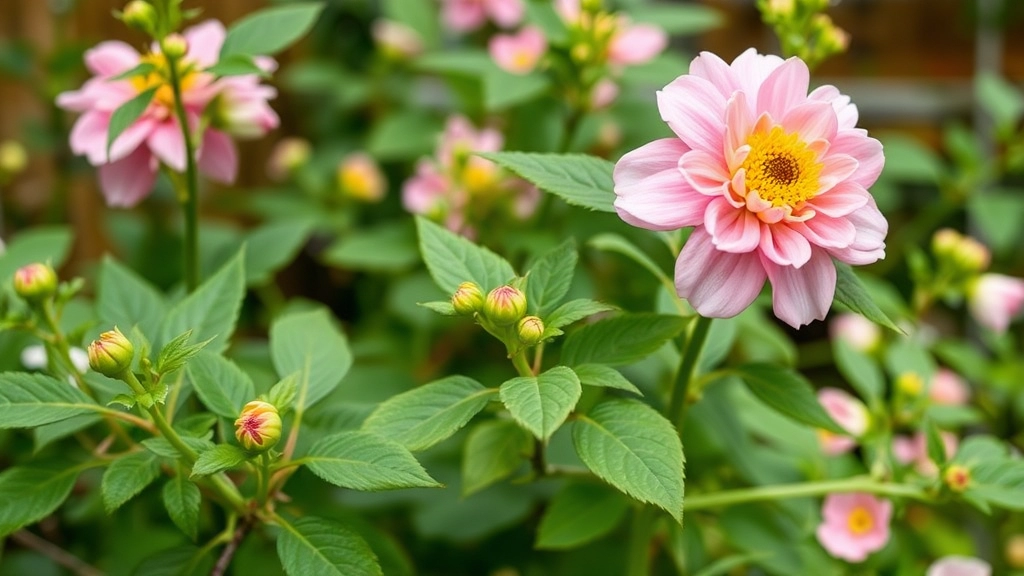
Have you ever noticed your Kalanchoe looking a bit tired after its blooming season? You’re not alone! Many plant lovers wonder how to revive their florist Kalanchoe and encourage it to produce more flowers.
Pruning and Deadheading Basics
Pruning and deadheading are two essential techniques that can significantly boost your Kalanchoe’s flower production. Here’s how to do it:
- Deadheading: This is simply removing spent blooms. Snip off flowers that have faded to encourage the plant to focus its energy on producing new buds.
- Pruning: Trim back any leggy or overgrown stems. This helps maintain a bushy shape and promotes airflow, reducing the risk of diseases.
When to Prune and Deadhead
Timing is everything! Here’s a quick guide:
- After Blooming: Once your Kalanchoe has finished its blooming cycle, it’s the perfect time to deadhead and prune.
- Regular Maintenance: Keep an eye on your plant throughout the growing season. If you see any dead flowers or unruly stems, don’t hesitate to snip them away.
Tips for Effective Pruning
Here are a few handy tips to make pruning easier:
- Use Clean Tools: Always use sharp, clean scissors or pruning shears to avoid spreading disease.
- Cut Above a Leaf Node: This encourages new growth from the node below, leading to a healthier plant.
- Don’t Overdo It: Prune sparingly. You want to encourage growth, not stress the plant.
By incorporating these practices, you’ll not only enhance the appearance of your Kalanchoe but also promote a more vigorous blooming cycle.
Preparing Florist Kalanchoe for Reblooming
As we wrap up our discussion on caring for Florist Kalanchoe, it’s essential to focus on how to prepare your plant for reblooming. Many enthusiasts often wonder why their Kalanchoe isn’t flowering again after its initial bloom.
To encourage your Kalanchoe to produce vibrant flowers once more, consider the following steps:
- Light Adjustment: After the blooming period, reduce the amount of light your plant receives. A period of darkness for about 14 hours a day can trigger the reblooming process. Learn more about the optimal light for Kalanchoe.
- Pruning: Trim back any dead or wilted flowers and leaves. This not only improves the plant’s appearance but also redirects energy towards new growth.
- Watering Routine: Gradually decrease watering. Allow the soil to dry out between waterings to encourage the plant to focus on producing flowers rather than foliage.
- Temperature Control: Keep your Kalanchoe in a cooler environment (around 15-18°C) for a few weeks. This change can stimulate the plant to produce new buds.
- Fertilisation: After pruning, apply a balanced fertiliser to provide essential nutrients. Opt for a fertiliser high in potassium to promote blooming.
By following these straightforward tips, you can successfully prepare your Florist Kalanchoe for another stunning display of flowers. For more detailed care tips, check out our guide on post-flowering care tips for Kalanchoe.
FAQs on Florist Kalanchoe Plant Care
How often should I water my Florist Kalanchoe?
Generally, you should water your Kalanchoe every 2-3 weeks. Adjust the frequency based on the season—more often in summer and less in winter.
How can I prevent overwatering my Kalanchoe?
To prevent overwatering, check the soil moisture by sticking your finger about an inch deep into the soil. Water only if it feels dry. Also, use well-draining pots and ensure thorough watering with complete drainage.
What light conditions are ideal for a Florist Kalanchoe?
Kalanchoe thrives in bright, indirect sunlight. Avoid harsh afternoon sun to prevent leaf scorching and to prolong blooming periods.
How can I encourage longer blooms on my Kalanchoe?
Ensure proper light exposure, maintain a comfortable temperature between 18°C and 24°C, and water only when the top inch of soil is dry. Regularly deadhead spent flowers and use a balanced, water-soluble fertilizer every two weeks during the blooming season.
What are the best methods for propagating Kalanchoe?
You can propagate Kalanchoe through cuttings, offsets, and seeds. Cuttings involve snipping healthy stems and planting them after they callous. Offsets can be separated from the base of the parent plant and replanted. Seeds can be sown on a seed-starting mix and misted to maintain moisture.
When should I prune and deadhead my Kalanchoe?
Prune and deadhead after your Kalanchoe has finished its blooming cycle. Regular maintenance throughout the growing season is also beneficial. Remove dead flowers and trim overgrown stems as needed.
What tools should I use for pruning my Kalanchoe?
Always use sharp, clean scissors or pruning shears to avoid spreading disease. Make sure to cut above a leaf node to encourage new growth.
Can I move my Kalanchoe frequently?
It’s best to avoid moving your Kalanchoe frequently, as it can stress the plant. Consistency in its environment helps encourage extended blooming.
What should I do if my Kalanchoe’s leaves start to yellow?
Yellowing leaves can be a sign of overwatering. Check the soil moisture and adjust your watering practices accordingly. Ensure your pot has proper drainage to prevent root rot.
References
-
Kalanchoe Care Guide – The Spruce
-
How to Care for a Kalanchoe Plant – Gardening Know How
-
Kalanchoe: How to Grow and Care for Kalanchoe Plants – The Old Farmer’s Almanac
